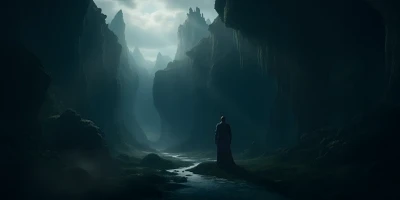The Fine Balance of World‑Building
Article • Saturday February 1, 2025

One of the most intriguing and unique aspects of speculative fiction—encompassing fantasy, science fiction, horror, and the myriad of sub-genres in between—is the fine art of world-building.
Yes, an argument could be made that world-building applies to all forms of fiction, shaping the narrative world in which the reader is immersed. But spy thrillers, murder mysteries, romance, and other genres that do not delve into the speculative tend to reflect a world that is already known and familiar. These stories rely on real-world places, peoples, histories, and sciences that the audience can readily understand.
Conversely, speculative fiction thrives in the realm of the unfamiliar, woven seamlessly into the familiar. It brings forth the eldritch and the fey, distant planets and dreadful monsters. It is the act of building something new—whether by layering it onto the framework of our existing world or by allowing it to stand entirely on its own.
Why World-Building Matters
For me, world-building is one of the most exhilarating aspects of storytelling and something I’ve been actively pursuing since I was a teen growing up in the mid-90s. It doesn’t just provide the backdrop upon which characters enact their journeys; in many ways, it shapes and informs those journeys. Whether it’s part of a sprawling epic fantasy, a raucous steampunk adventure, or a reimagined fairytale set in a fictional village or castle, the world defines the tone, enhances immersion, and enriches the reader’s experience.
Yet, world-building requires a delicate balance.
Too much focus on world details can overwhelm the reader, bogging down the narrative in excessive exposition. Conversely, too little world-building can leave the story feeling flat or uninspired, lacking the depth necessary to fully engage the audience.
The Weight of the World
Given its significance, world-building can sometimes feel like an immense burden. It’s easy to feel like you have to have it all sorted out, ensuring that every detail is clearly codified before your characters can take their first step onto the stage of your story.
While this approach may initially seem productive, I’ve found that it can quickly become overwhelming and even paralyzing. This burden can grow to the point where it drains the joy from the writing process, turning creativity into a chore.
Even if you genuinely enjoy immersing yourself in the intricate details of world-building, there’s still the real danger of getting lost in the proverbial weeds—spending so much time on details that the story itself never takes shape. If your ultimate goal is to write a story, then the simple reality is that it's never going to happen if you spend all of your time and energy building out the world.
Ultimately, the story itself must take precedence. If the curtain never opens and the drama never unfolds upon the stage of your remarkable world, what was the point of all those hours spent building it?
Striking the Right Balance
So, how do we find that balance?
This is a topic I’d like to explore over a series of articles by reflecting on my experiences in fantasy literature—both as a reader and a writer. Throughout this series, we will examine key topics, including:
- Establishing Scope – How much of your world do you need to develop?
- Defining Purpose – Does the world serve the story, or does the story serve the world?
- Creating a Hierarchy – What details are essential, and what can remain vague?
- Unfolding the Details – Letting the world reveal itself naturally instead of overwhelming the reader with exposition.
- Showing Over Telling – Immersing readers through action and dialogue rather than overt descriptions.
Before diving into these specifics, it’s important to recognize that the balance of world-building is not static—it can shift over time.
The ideal balance of world-building in Book 1 of a series may no longer apply by Book 4. As the series progresses, the world may become so well-established in the reader’s mind that extensive descriptions become unnecessary, allowing characters and storylines to take center stage.
Of course, the opposite can also be true. A story that begins with a small band of heroes fighting to save an isolated kingdom (or planet) may spill into a larger world (or universe), necessitating a broader range of detail to bring the expanding scope to life.
Even within a single book, the balance may shift depending on the pacing and narrative focus. Early chapters might require more world-building to establish context, while later sections lean into character development and plot momentum.
Final Thoughts
As we navigate this discussion, I want to emphasize that the ideas I present are exactly that—ideas. Like all aspects of writing, world-building is an art rather than a strict formula. With this series, I aim to offer concepts and strategies that you can ponder and adapt to your own writing process.
Whether you’re a meticulous planner who maps out every facet of your world before writing or a discovery writer who builds the setting as the story unfolds, the key is always balance. A well-crafted world should serve as both a foundation and a living entity that enhances the storytelling experience.
So, let’s embark on this journey together and explore what makes a world truly come alive.
Ready for Your Next Adventure?
Follow Caleb Rusk as he’s drawn into a conflict far greater than he ever imagined. Discover The First of Shadows today.

